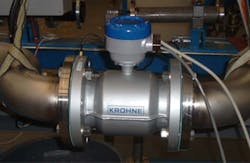When a flowmeter doesn’t work properly, it is fairly easy to make the case for upgrading to a new one. But it can be harder to justify the need for a replacement when the existing meter is doing its job. How can you make the case for an upgrade when there hasn’t been a change in the process or the need for enhanced performance isn’t immediately obvious? Likewise, how can you effectively determine when a flowmeter upgrade is in order?
Evaluating A Meter for Upgrade
According to Joe Incontri, director of marketing at KROHNE Inc., a supplier of process measurement instruments including flowmeters, there are several possibilities to consider when evaluating the need for an upgrade. Some may deal with ongoing problems, such as pervasive maintenance requirements or diminished performance due to process design changes that may have affected the operating range of the meter.
When considering a flowmeter upgrade, Incontri says a decision tree might include the following questions:
- Is the meter operating within its designated optimal performance envelope? Each meter type is different. For example, differential-pressure (DP) or variable-area-based meters operate best in the upper portion of the flow range since they are non-linear devices.
- Does the meter exhibit frequent issues that make it unreliable in normal use? If this is the case, then it may be that the meter has exceeded its useful lifespan.
- Has the process changed or has the understanding of the process changed, thereby rendering the meter useless because it no longer fits the application for which it was specified? This could be a material selection situation or simply a sizing question.
- Is enhanced performance or additional information required? Several new-technology meters feature advanced diagnostics or additional process information that can add a qualitative aspect to the quantitative measurement usually provided by a standard flowmeter.
These are just a few examples of reasons why an upgrade might be beneficial.
Best Practices
Specific operating practices will dictate how instrumentation is deployed, maintained and evaluated, however, there are a few best practices that can be applied, in general, for evaluating the effectiveness of an existing flow measurement system. For instance, maintenance records can be a source of information for the performance of flowmeter systems. Analyzing the flow measurment with portable flowmeters, such as clamp-on ultrasonic flowmeters, is also a good way to determine if the installed flowmeters are operating as expected. “The simple checks often times yield sufficient information to determine the effectiveness of existing flow measurement systems,” Incontri says. “More advanced instrumentation systems now include asset management databases, which provide a broad range of data that can be used to evaluate specific instrumentation results.”
How to Make the Case for a Pricier Meter
When weighing the pros and cons of a flowmeter upgrade, cost will be an undeniable factor. Incontri says overcoming this obstacle must be done by the technical specifier. “He must be convinced that the return on the investment is substantial enough and quick enough to overcome the cost of change,” he says. Making a case for a more expensive meter can be achieved by providing evidence that a new meter will demonstrate improved measurement performance, ease-of-use, reduced maintenance, reliability, and ruggedness. “Assigning a factor to these benefits is where the personal experience of the specifier along with the recommendations of the vendor can play a significant role in the success of a new meter implementation,” Incontri says.



